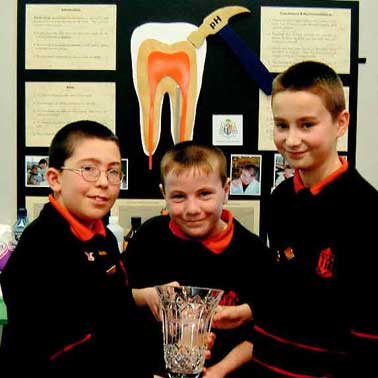| 2004 |

|
YEAR BOOK |
O'Fiaich College, Dublin Road, Dundalk, Co. Louth
|
Diet & oral pH: methods to improve oral health
|

Plaque is a collection of bacteria that adheres to your teeth and gets its energy by breaking down the sugars in food you eat. During the breakdown of food, many products are formed, one of which is lactic acid, which decreases the pH in your mouth. In an acidic environment, the hard enamel that protects your teeth dissolves, which leaves your teeth vulnerable to decay and cavities.
Our study on oral pH found that plaque bacteria produce acid on the surface of the teeth five to ten minutes after the consumption of a sucrose solution. The oral pH of the participants in our study was at its lowest five to fifteen minutes after drinking a sucrose solution. Studies have shown that if pH drops below 5.3, the enamel on the surface of the teeth gets broken down. This is called demineralisation. The opposite of demineralisation is called remineralisation. The acids formed by plaque can be counteracted by simple saliva in your mouth, which acts as a buffer and remineralising agent.
We found that brushing and flossing reduced the amount of plaque bacteria on teeth, and the teeth were not subjected to low pH. Also, the chewing of gum prevents the pH dropping if chewed after eating or drinking. The pH in the mouth of people who chewed gum remained constant. Interestingly though, foods like cheese and ham didn't have an effect on oral pH, while the consumption of oranges and bread lowered oral pH.
The best way to combat dental decay cavities is to follow three simple steps:
-
�Cut down on sweets and between-meal snacks. Remember, it's these sugary and starchy treats that put your teeth at extra risk.
-
�Brush after every meal and floss daily. Cavities most often begin in hard-to-clean areas between teeth and in the fissures and pits.
-
�See your dentist at least every six months for checkups and professional cleanings. Because cavities can be difficult to detect, a thorough dental examination is very important.
| This article was sponsored by the Dental Health Foundation |
|---|